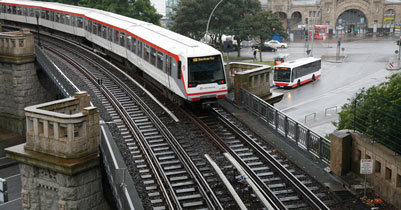Hamburg: HOCHBAHN seeks more passengers via new corporate strategy
- Like
- Digg
- Del
- Tumblr
- VKontakte
- Buffer
- Love This
- Odnoklassniki
- Meneame
- Blogger
- Amazon
- Yahoo Mail
- Gmail
- AOL
- Newsvine
- HackerNews
- Evernote
- MySpace
- Mail.ru
- Viadeo
- Line
- Comments
- Yummly
- SMS
- Viber
- Telegram
- Subscribe
- Skype
- Facebook Messenger
- Kakao
- LiveJournal
- Yammer
- Edgar
- Fintel
- Mix
- Instapaper
- Copy Link
Posted: 3 March 2014 | Günter Elste, Hamburger Hochbahn AG | No comments yet
Since 2006, the passenger numbers of Hamburger Hochbahn AG (HOCHBAHN) have increased by 2.5% on an annual average. At the same time, the absolute passenger numbers of Germany’s second-largest local public transport company, which operates the underground railways of Hamburg and most of its bus lines and hence accounts for around 55% of the city’s local public transport, rose by 18% overall from 373 million (2006) to approximately 440 million (end-2013)…


HOCHBAHN seeks more passengers via new corporate strategy
The trend of further increasing passenger numbers in Germany’s big cities – and this applies to Hamburg in particular – will continue in the future. Solid economic growth combined with new employment opportunities and the steady trend to ‘urbanise’ will attract more and more people to work and live in the cities. At the same time, mobility requirements will also increase, as people will require mobility around the clock in the intra-urban environment, but also outside the city.
Simultaneously, Hamburg faces major environmental challenges, which can only be met by means of an efficient, attractive and intensely used local public transport system. Compared to 1990, the CO2 emissions of Hamburg are supposed to decrease by 40% by 2020 and 80% by 2050. Moreover, the European Union has set high standards in terms of air pollution control. Parallel to this change of framework conditions, people’s expectations in the quality of urban life likewise increase. Individual passenger vehicle utilisation often conflicts with these objectives. In addition, only limited street space is available, as traffic jams and the search for a parking place turn into a burdensome day-to-day task.
Commitment to growth
Therefore, the development of inner-city mobility is of outstanding significance to the metropolis of Hamburg. With its new, long-term corporate strategy, HOCHBAHN has committed itself to the objective of sustainable growth in terms of passenger numbers. In this context, we anticipate a further increase of passenger numbers to 525 million by 2020 and up to 600 million by 2030. Only on this basis can the ambitious objectives of the Free and Hanseatic City of Hamburg be brought in line with the requirements of a rising urban and commuter population. However, one would be mistaken to believe that those new passengers will come automatically. Instead, enormous efforts will have to be made to convince both new and existing passengers by means of a convenient service package to refrain significantly more often from using their own passenger car or do without one altogether and switch to local public transport.
The systematic extension of transport services is an integral part of our corporate strategy, while taking into consideration that any such extension also needs to be economically profitable. The economic success of HOCHBAHN, which is reflected – among other things – in one of Europe’s highest cost coverage ratios (90%), remains an essential objective to be achieved not least because of the tight public budgets. At the same time, major future-oriented projects for an extension of the underground railway network are in the planning stages for the next two decades. To better develop large residential settlements, link new housing estates to the local public transport system and provide relief for roads and streets, about 30 variants are currently under consideration. Still in the course of this year, various concepts are supposed to be presented. As far as it proves possible, specific plans and schedules for the first new transport routes shall get underway in 2015 after a corresponding decision has been taken by the political decision-makers.
However, our company’s strategic agenda does not only include the extension of our infrastructure or the ‘vehicle fleet’, so as to raise the number of passengers. For after all, the attractiveness of local public transport and its degree of utilisation also depend essentially on the ways in which the transition between individual and public mobility is shaped. Therefore, we consider three projects in particular as a top priority, deserving consistent expedition in the framework of the HOCHBAHN 2030 strategy.
Barrier-free stations
The barrier-free extension of the largely 100-year-old underground system has received significant financial support from the incumbent Senate of Hamburg, which, however, is also associated with very high requirements. By the beginning of the next decade, all underground railway stations are expected to provide barrier-free access. In this context, it must be taken into consideration that the share of barrier-free stations was only 40% in 2012. While, up to that time, the city only funded the redevelopment of about one station each year, the new target is now at least five stations a year. The resulting tasks (installation of lifts, platform elevations, installation of control systems etc.) in a 100-year-old system with minimal disturbance to the on-going transport operations are one of the greatest challenges currently faced by our engineers. Taking this consideration, it is extremely pleasing news that we are currently fully in line with the time and cost schedule of this project. Slightly less than two thirds of all stations are going to be barrier-free by 2015.
Enhancing high-speed railway station surrounding areas
Another important project for the next decade is the enhancement of the surrounding areas of Hamburg’s high-speed railway stations. In addition to the 91 underground railway stations that belong to HOCHBAHN itself, the regional government also commissioned us to include the surrounding areas of the high-speed railway stations (the high-speed railway system is operated by a subsidiary of DB AG) in the project, which therefore covers a total of more than 150 stations. The objective is to make access to local public transport not only more attractive, but also more user-friendly by means of enhancing the surrounding areas of the stations (cleanliness, brightness, structural condition etc.). This also includes the modernisation of 11,000 existing and the creation of 11,000 new bicycle parking places. The enhanced appearance of local public transport environments will make it easier for people to waive the possession and use of an own passenger car. In this context, the role of the bicycle in the inner-city sections of the town must not be underestimated. Parallel to this, we shall also re-engineer our park-and-ride strategy, as we combine a considerable capacity extension with a significant qualitative upgrading of existing facilities.
Changing mobility habits
The third project to be mentioned in this context provides evidence that HOCHBAHN is embracing the perceivable change of mobility culture and applies new methods, which will serve as a role model as well for other local public transport companies. While possession of a passenger car or even two or three passenger cars used to be of high significance in the past because of various reasons (prestige etc.), the benefits analysis now shifts increasingly towards the fulfilment of mobility requirements. In short, this means ‘using rather than possessing’. In this context, the rising costs of passenger car possession and the increasingly scarce street space with traffic jams and a shortage of parking places play a major role alongside the reduced prestige factor. For local public transport, this leads to increased readiness at least among city inhabitants to do without an own passenger car, provided they are able to satisfy their mobility requirements through other means of transport.
In the future, the bigger part of inner-city mobility requirements will continue to be covered by local public transport in the form of railways, buses and ferries. This trend is supported, among other things, by the relatively low price in comparison to passenger cars, the comfortable use (reduced stress factor) and avoidance of the individual costs of traffic jams and parking place searches. However, the inhabitants of big cities also have mobility requirements that cannot be covered at all or only insufficiently by local public transport – be it big shopping trips in supermarkets or furniture stores in the countryside, or be it weekend visits to relatives or family outings. Car sharing and rental vehicles may represent solutions to meet such mobility requirements without having to use an own passenger car.
Complementary mobility services
Further solutions can be added to these complementary transport services such as rental bike systems which have been introduced very successfully in Hamburg and other big European cities, or taxi and other transportation services. These systems do not represent competition for us. On the contrary: comprehensive, low-priced and convenient complementary mobility services strengthen the utilisation of local public transport, as they support the readiness among city inhabitants to do without an own private passenger car as a permanent basic resource of individual mobility.
switchh
For that reason, we launched a mobility project named switchh (the double ‘h’ standing for ‘Free and Hanseatic city Hamburg’) at the end of May 2013, which is unique thus far throughout Europe. Together with initially two partners, the short-time car leasing company car2go and the rental car provider Europcar, HOCHBAHN offers its regular customers (subscription customers) attractive discounts for complementary mobility services at an additional price of €10 per month. switchh customers get the first 60 minutes of car2go utilisation free-of charge-and save €20 each time they hire a Europcar anywhere in Germany. The car2go discount alone represents a monetary value of up to €17.40. Following online registration, every customer receives a switchh card, which provides access to the vehicles of car2go and, at the same time, works as a Europcar customer card.
Another important component of the switchh service is the ‘switchh point’, which provides local public transport customers with very convenient access to the complementary mobility services. The first switchh point was opened in late-May 2013 at the high-speed railway intersection Berliner Tor, which is frequented by more than 100,000 passengers every day. Here, the car2go and Europcar vehicles are made available for utilisation on special parking areas. Convenient parking places for private bikes, a large rental bike provider and private taxis on-site complement the service. The inclusion of the rental bike provider and the Hamburg taxi operators as regular project partners is scheduled for the further course of this year. In the coming years, up to 15 fixed switchh points, clearly visible in the urban landscape, are to be opened at highly frequented local public transport intersections. In addition, high residential and job density levels and scarce parking space in the surrounding areas also constitute important factors for the choice of locations.
Together with its employees and partner companies, HOCHBAHN has been the first transport company in Germany to develop a mobility platform for the integration and connection of complementary mobility services in local public transport. The mobility platform brings together the various transport services and makes them available to customers via an app or the Internet. The user receives multi-modal information about the services offered, i.e. gets a display of alternative options for their specific mobility requirements. They are able to select the optimal service offered and reserve or book this service directly, easily and conveniently with only a few clicks.
Within the pilot project, scheduled until mid-2015 on the basis of a two-year term, we anticipate around 9,000 switchh customers. The first months have already revealed massive interest in the project, which is likely to rise even more as the level of public presence increases. Plans already go beyond the pilot project phase. Further partners with additional services offered and even more locations are supposed to form an attractive package of local public transport and complementary mobility services and convince as many citizens of Hamburg as possible of their ability to spare the possession of an own passenger car.
In our HOCHBAHN 2030 strategy, we have defined our new role as an ‘organiser of complementary mobility’. Even though HOCHBAHN itself does not wish to act as a provider of complementary mobility services, we do consider it our role and obligation to offer and organise transport solutions, which are capable of covering the requirements of city inhabitants and rise to the future challenges of our city.
Biography
In 1974, Günter Elste graduated at the University of Hamburg in Business Management. After joining the Planning Staff of the Free and Hanseatic City of Hamburg he became Head of Staff Administration and Authorised Signatory in the Housing Industry. In 1989 Günter was promoted to the position of Managing Director of the Hamburger Gesellschaft für Beteiligungsverwaltung – the holding company of the state-owned enterprises of the Free and Hanseatic City of Hamburg. In 1996 Günter was appointed Chairman of the Hamburger Hochbahn AG, the second largest public transport company in Germany. In addition, from 1985 to 1997 he was Member of the Parliament of the Free and Hanseatic City of Hamburg. Between 1989 and 1996 he was the Parliamentary Party Chairman in the Parliament of the Free and Hanseatic City of Hamburg (Bürgerschaft). From June 2003 until November 2009 Günter was the elected Chairman of the Association of German Transport Companies, Verband Deutscher Verkehrsunternehmen (VDV).
Related topics
Business Models
Issue
Issue 1 2014
Related cities
Germany
Related organisations
Hamburger Hochbahn AG (HOCHBAHN)





